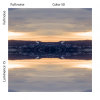Stretching the truth is deception. They picked the route which deviated from the industry standard for lens sizes as read, to make their product look better than what it is. Hey, that’s the way the world is. I was just making note of it.It is not deception per se, merely a historic leftover.
citing Image Sensor Sizes:
‘When the vidicon tube was invented in the early 1950s, the glass tubing used to make the first units had a nominal exterior diameter of one inch. These were referred to as "One-inch tubes". After allowing for the space taken up by the interior metal structures needed to control the electron beam, the portion of the photoconductor on the front glass accessible for scanning had a diameter of about 5/8 inch. Early television used a raster aspect ratio of 4:3 so the corresponding scanned area was 1/2 inch horizontal by 3/8 inch vertical - the canonic 3:4:5 right triangle. After a while, the image size assumed the name of the tube and a 5/8 inch diagonal raster became commonly called the 1-inch size. 5/8 inch is 15.875 mm and so 16 mm became the designated metric diagonal for 1-inch tubes.”
And the main issue with the sensor is not the size but rather the (color) noise which is quite easily mitigated as per my previous answer.
Advertising takes liberties that sometimes goes too far.







